Papers by Michael Phillips
Journal of Burn Care & Research, 2014

Burns, 2015
As minor burn patients constitute the vast majority of a developed nation case-mix, streamlining ... more As minor burn patients constitute the vast majority of a developed nation case-mix, streamlining care for this group can promote efficiency from a service-wide perspective. This study tested the hypothesis that a predictive nomogram model that estimates likelihood of good long-term quality of life (QoL) post-burn is a valid way to optimise patient selection and risk management when applying a streamlined model of care. A sample of 224 burn patients managed by the Burn Service of Western Australia who provided both short and long-term outcomes was used to estimate the probability of achieving a good QoL defined as 150 out of a possible 160 points on the Burn Specific Health Scale-Brief (BSHS-B) at least six months from injury. A multivariate logistic regression analysis produced a predictive model provisioned as a nomogram for clinical application. A second, independent cohort of consecutive patients (n=106) was used to validate the predictive merit of the nomogram. Male gender (p=0.02), conservative management (p=0.03), upper limb burn (p=0.04) and high BSHS-B score within one month of burn (p<0.001) were significant predictors of good outcome at six months and beyond. A Receiver Operating Curve (ROC) analysis demonstrated excellent (90%) accuracy overall. At 80% probability of good outcome, the false positive risk was 14%. The nomogram was validated by running a second ROC analysis of the model in an independent cohort. The analysis confirmed high (86%) overall accuracy of the model, the risk of false positive was reduced to 10% at a lower (70%) probability. This affirms the stability of the nomogram model in different patient groups over time. An investigation of the effect of missing data on sample selection determined that a greater proportion of younger patients with smaller TBSA burns were excluded due to loss to follow up. For clinicians managing comparable burn populations, the BSWA burns nomogram is an effective tool to assist the selection of patients to a streamlined care pathway with the aim of improving efficiency of service delivery.
This article appeared in a journal published by Elsevier. The attached copy is furnished to the a... more This article appeared in a journal published by Elsevier. The attached copy is furnished to the author for internal non-commercial research and education use, including for instruction at the authors institution and sharing with colleagues. Other uses, including reproduction and distribution, or selling or licensing copies, or posting to personal, institutional or third party websites are prohibited. In most cases authors are permitted to post their version of the article (e.g. in Word or Tex form) to their personal website or institutional repository. Authors requiring further information regarding Elsevier's archiving and manuscript policies are encouraged to visit: http://www.elsevier.com/authorsrights
This article appeared in a journal published by Elsevier. The attached copy is furnished to the a... more This article appeared in a journal published by Elsevier. The attached copy is furnished to the author for internal non-commercial research and education use, including for instruction at the authors institution and sharing with colleagues. Other uses, including reproduction and distribution, or selling or licensing copies, or posting to personal, institutional or third party websites are prohibited. In most cases authors are permitted to post their version of the article (e.g. in Word or Tex form) to their personal website or institutional repository. Authors requiring further information regarding Elsevier's archiving and manuscript policies are encouraged to visit: http://www.elsevier.com/copyright
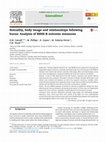
Sexuality Body image Relationships Burns Specific Health Scale-Brief a b s t r a c t Background: ... more Sexuality Body image Relationships Burns Specific Health Scale-Brief a b s t r a c t Background: The Burns Specific Health Scale -Brief (BSHS-B) was analyzed to investigate the longitudinal impact of burns on sexuality and body image. Four sub-domains of the BSHS-B domains were of particular interest: sexuality, body image, affect and relationships, and as such were investigated for correlation between all of the sub-scales of the BSHS-B. Methods: A total of 1846 observations from 865 Western Australian burn patient BSHS-B questionnaires were analyzed. Descriptive statistical methods included dichotomous and ordinal scale variables and medians, as well at the range for continuous variables. Inferential statistical methods used longitudinal linear mixed-effects models and random effects models with the BSHS-B total and its sub-scales as dependent variables. Results: The four BSHS-B domains of interest all showed no significant change over time, indicating that the psychological and psychosocial impact of burns does not significantly improve for burn survivors, regardless of good physical and functional recovery.
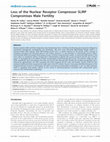
Nuclear receptors (NRs) and their coregulators play fundamental roles in initiating and directing... more Nuclear receptors (NRs) and their coregulators play fundamental roles in initiating and directing gene expression influencing mammalian reproduction, development and metabolism. SRA stem Loop Interacting RNA-binding Protein (SLIRP) is a Steroid receptor RNA Activator (SRA) RNA-binding protein that is a potent repressor of NR activity. SLIRP is present in complexes associated with NR target genes in the nucleus; however, it is also abundant in mitochondria where it affects mitochondrial mRNA transcription and energy turnover. In further characterisation studies, we observed SLIRP protein in the testis where its localization pattern changes from mitochondrial in diploid cells to peri-acrosomal and the tail in mature sperm. To investigate the in vivo effects of SLIRP, we generated a SLIRP knockout (KO) mouse. This animal is viable, but sub-fertile. Specifically, when homozygous KO males are crossed with wild type (WT) females the resultant average litter size is reduced by approximately one third compared with those produced by WT males and females. Further, SLIRP KO mice produced significantly fewer progressively motile sperm than WT animals. Electron microscopy identified disruption of the mid-piece/annulus junction in homozygous KO sperm and altered mitochondrial morphology. In sum, our data implicates SLIRP in regulating male fertility, wherein its loss results in asthenozoospermia associated with compromised sperm structure and mitochondrial morphology.
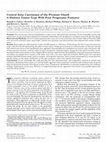
Purpose: The central zone of the prostate gland is a region rarely associated with carcinoma. To ... more Purpose: The central zone of the prostate gland is a region rarely associated with carcinoma. To our knowledge central zone tumors have not previously been compared to carcinoma originating in the peripheral or transition zone of the prostate gland. Materials and Methods: All 2,010 radical prostatectomy cases seen at our institution from October 1998 to December 2006 were reviewed to identify tumor zonal origin. Central zone carcinoma was characterized and compared with tumors of other zones. Results: Zonal origin was determined in a total of 2,494 tumors in 1,703 cases. Of the tumors 63 (2.5%) were of central zone origin with 59 of the 63 representing the index or main tumor. Comparative analysis of a defined subset of 726 cases showed that central zone cancers were significantly more aggressive than peripheral or transition zone cancers with a far greater risk of extracapsular extension, seminal vesicle invasion and positive surgical margins. Escape from the gland was often via the ejaculatory ducts and seminal vesicles. Kaplan-Meier analysis confirmed that the probability of post-prostatectomy biochemical failure was double that of tumors of the other zones with a far more rapid rate of failure. Multivariate Cox regression analysis identified Gleason grade, positive margins, extracapsular extension, tumor volume and preoperative serum prostate specific antigen as the major contributors to this poor prognosis, rather than specific zonal origin. Conclusions: To our knowledge this study provides the first characterization and comparative analysis of central zone carcinoma, identifying these tumors as a rare but highly aggressive form of prostate carcinoma with a distinct route of spread from the gland that contrasts with tumors of other zones. Preoperative identification is currently hampered by the avoidance of biopsy targeting the central zone. However, if recognized preoperatively, aggressive intervention may possibly improve the currently bleak outlook. T he enigmatic behavior of prostate cancer, which results in a uniquely low ratio of pathological disease to cancer mortality, may be partly explained by differences in the biological behavior of tumors originating from various geographic zones of the gland. McNeal et al described 4 distinct zones of the prostate gland with 68% of cancers arising in the PZ, often associated with HG-PIN or dysplasia. 1,2 In contrast, 24% of tumors arose in the TZ and 8% arose in the CZ, where a precursor or dysplastic lesion was not described. The anterior fibromuscular zone does not contain epithelial structures and it does not give rise to carcinoma. 2 Most aggressive or high grade tumors are peripherally located with easy egress from the gland via large, posterolaterally located penetrating nerves. TZ cancers are mostly low grade, do not have access to the posteriorly located autonomic nerve trunks and remain confined to the gland despite their large volume and associated high serum PSA. Escape from the prostate gland has been noted in a minority of cases and it was often via the bladder neck with subsequent trigonal invasion. 3,4 McNeal first described the anatomical features of the posteriorly located, conical CZ, clearly distinguishing it from the PZ. 5 The CZ accounts for 25% of total prostate mass but almost 40% of epithelial mass due to its high epithelial-to-stromal ratio. 1,3 The glands in the CZ are of large caliber (twice that of the PZ), showing a unique Roman bridge architecture with the formation of intraglandular lacu-nae. 3,6,7 Its secretory profile is also unique, including cytoplas-mic lactoferrin, tissue plasminogen activator, 3,6 endothelin-1 and numerous lipochrome pigments. 8 Recent comparative studies of the prostate zones provide further evidence that the normal CZ differs from the PZ and TZ, and has features part way between the seminal vesicles and the epithelium of the other prostate zones. 9,10 CZ cancers and their precursor lesions represent the least understood of the zonal neoplasms and little is known of their biological behavior. It is rare for CZ tumors to be distinguished or reported separately from those of the PZ or TZ. We identified and characterized carcinomas arising in the CZ and compared their histological and clinical features to tumors arising in other zones of the prostate gland.
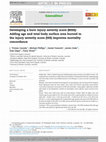
b u r n s x x x (2 0 1 3) x x x – x x x a b s t r a c t Background: There is limited research val... more b u r n s x x x (2 0 1 3) x x x – x x x a b s t r a c t Background: There is limited research validating the injury severity score (ISS) in burns. We examined the concordance of ISS with burn mortality. We hypothesized that combining age and total body surface area (TBSA) burned to the ISS gives a more accurate mortality risk estimate. Methods: Data from the Royal Perth Hospital Trauma Registry and the Royal Perth Hospital Burns Minimum Data Set were linked. Area under the receiver operating characteristic curve (AUC) measured concordance of ISS with mortality. Using logistic regression models with death as the dependent variable we developed a burn-specific injury severity score (BISS). Results: There were 1344 burns with 24 (1.8%) deaths, median TBSA 5% (IQR 2–10), and median age 36 years (IQR 23–50). The results show ISS is a good predictor of death for burns when ISS 15 (OR 1.29, p = 0.02), but not for ISS > 15 (ISS 16–24: OR 1.09, p = 0.81; ISS 25–49: OR 0.81, p = 0.19). Comparing the AUCs adjusted for age, gender and cause, ISS of 84% (95% CI 82–85%) and BISS of 95% (95% CI 92–98%), demonstrated superior performance of BISS as a mortality predictor for burns. Conclusion: ISS is a poor predictor of death in severe burns. The BISS combines ISS with age and TBSA and performs significantly better than the ISS. Please cite this article in press as: Cassidy JT, et al. Developing a burn injury severity score (BISS): Adding age and total body surface area burned to the injury severity score (ISS) improves mortality concordance. Burns (2013), http://dx.
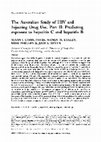
Researchers agree that while hepatitis B maybe in control, hepatitis C is present in epidemic pro... more Researchers agree that while hepatitis B maybe in control, hepatitis C is present in epidemic proportions among injecting drug users and that current HIV prevention strategies have not been sufficient to halt the spread of this hepatitis virus, although there is some evidence to suggest that incidence rates are stabilizing. Since there is no effective cure and it is unlikely that a vaccine will become available in the foreseeable future all efforts to control the spread of hepatitis C must rely on education and prevention strategies. The Australian Study of HIV and Injecting Drug Use is a cross-sectional national study designed to investigate exposure to and risks for infection with blood-bome viruses. Of those volunteering a usable blood sample for hepatitis C antibody and hepatitis B core antibody testing 55% and 19%, respectively, returned reactive test results. Logistic regression statistical models were used to identify risk factors for hepatitis C and hepatitis B. Risk factors for hepatitis C were identified as duration of use, use of opiates on last injecting occasion, education level, treatment status and having a history of sexually transmissible diseases. Risk factors associated with hepatitis B were duration of use, and use of opiates on last injecting occasion. The lack of identifiable risk factors for hepatitis B suggest that past rather than current injecting and sexual behaviour patterns are required to predict accurately risk of exposure to hepatitis B. In addition to this, one-third of respondents reported being vaccinated against hepatitis B. Respondents perceived themselves to be at greater risk from hepatitis C than from hepatitis B or HIV. A discussion of strategies needed to prevent the spread of the hepatitis viruses will be presented along with recommendations for further research. [Carruthers SJ, Loxley WH, Phillips M, Bevan JS. The Australian Study of HIV and Injecting Drug Use. Part II: Predicting exposure to hepatitis C and hepatitis B. Drug Alcohol Rev 1997;16:215-220.]
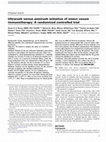
Background: Venom immunotherapy can be initiated by different schedules, but randomized compariso... more Background: Venom immunotherapy can be initiated by different schedules, but randomized comparisons have not been performed. Objective: We aimed to compare the safety of 2 initiation schedules. Methods: Patients of any age with prior immediate generalized reactions to jack jumper ant (Myrmecia pilosula) stings were randomized to venom immunotherapy initiation by a semirush schedule over 10 visits (9 weeks) or an ultrarush schedule over 3 visits (2 weeks). In a concurrent treatment efficacy study, the target maintenance dose was randomized to either 50 mg or 100 mg. The primary outcome was the occurrence of 1 or more objective systemic reactions during venom immunotherapy initiation. Analyses were by intention to treat. We also assessed outcomes in patients who declined randomization. Results: Of 213 eligible patients, 93 were randomized to semirush (44 patients) or ultrarush (49 patients) initiation. Objective systemic reactions were more likely during ultrarush initiation (65% vs 29%; P < .001), as were severe reactions (12% vs 0%; P 5 .029). Times to maximal increases in venom-specific
the infl ammatory process ( 1, 2 ), acting on a number of G-coupled protein receptors, including ... more the infl ammatory process ( 1, 2 ), acting on a number of G-coupled protein receptors, including the leukotriene B4 (LTB 4 ) receptor to affect resolution of infl ammation.
F 2-isoprostanes (F 2-IsoP's) are reliable measures of in vivo lipid oxidation, but care is requi... more F 2-isoprostanes (F 2-IsoP's) are reliable measures of in vivo lipid oxidation, but care is required to prevent artifactual elevation. We examined the effects of blood collection and storage on plasma F 2-IsoP's. Blood was collected into EDTA/butylated hydroxytoluene/reduced glutathione (EDTA/BHT/GSH) or EDTA, at 4 °C or room temperature. Plasma was stored at À20 or À80 °C for 1 or 6 months before F 2-IsoP's were assayed by GC–MS. The temperature of blood collection did not affect F 2-IsoP's. However, storage at À20 °C or collection into EDTA resulted in significant increases in F 2-IsoP's. Blood collection into EDTA/ BHT/GSH and storage at À80 °C minimizes artifactual elevation of plasma F 2-IsoP's.
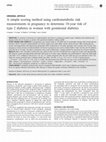
OBJECTIVE: To examine if clustering of cardiometabolic risk factors in pregnancy predicts type 2 ... more OBJECTIVE: To examine if clustering of cardiometabolic risk factors in pregnancy predicts type 2 diabetes and cardiovascular disease (CVD) risk at 10 years in women with gestational diabetes mellitus (GDM). STUDY DESIGN AND SUBJECTS: A prospective case–control study in 150 GDM and 72 overweight women with normal glucose tolerance (NGT) measured cardiometabolic risk factors (body mass index (BMI), systolic blood pressure (SBP), fasting glucose, insulin, and triglycerides and high-density lipoprotein (HDL) cholesterol) at 28 weeks gestation and 6 months and 10 years after pregnancy. Cluster analysis of cardiometabolic risk factors in pregnancy was used to stratify GDM as 'high' and 'low risk' for diabetes and CVD risk at 10 years. The data in pregnancy were used to determine a simple method for assessing risk of future diabetes. RESULTS: BMI in the 150 GDM at study entry was similar to NGT, but 35% of GDM fell into a 'high-risk cluster' with elevated BMI, SBP, glucose, insulin and triglycerides and lower HDL levels. At 10 years, type 2 diabetes was sixfold higher in 'high-risk' GDM (odds ratio (OR) ¼ 6.75, confidence interval (CI) ¼ 2.0, 22.7, P ¼ 0.002) compared with 'low-risk' GDM and was not reported in NGT. The 'high-risk' cluster predicted type 2 diabetes better than BMI430 (OR ¼ 2.13, CI ¼ 0.71, 6.4, P ¼ 0.179) or fasting glucose 45.5 mmol l –1 , (OR ¼ 4.56, CI ¼ 1.50, 13.85, P ¼ 0.007). We determined that GDM with any four of the cardiometabolic risk factors (BMI430 kg m –2 , fasting glucose45.0 mmol l –1 , insulin47.8 mU l –1 , triglycerides 42.4 mmol l –1 , HDLo1.6 mmol l –1 or SBP4105 mm Hg) in pregnancy would be in a 'high-risk' cluster. CONCLUSIONS: A metabolic syndrome-like cluster in pregnant GDM identifies risk for type 2 diabetes providing an opportunity to focus on rigorous lifestyle interventions after delivery to reduce the burden of disease attributed to this condition.
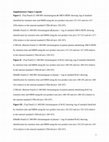
Supplementary Figure Legends Figure I. (Top Panel) LC-MS/MS chromatogram of 18R/S-HEPE showing 1n... more Supplementary Figure Legends Figure I. (Top Panel) LC-MS/MS chromatogram of 18R/S-HEPE showing 1ng of standard identified by retention time and MRM using the two product ions (m/z 317-215 and m/z 317-259) relative to the internal standard LTB4-d4 (m/z 339-197). (Middle Panel) LC-MS/MS chromatogram of plasma + 1ng of standard 18R/S-HEPE showing identification by retention time and MRM using the two product ions (m/z 317-215 and m/z 317-259) relative to the internal standard LTB4-d4 (m/z 339-197). LTB4-d4. (Bottom Panel) LC-MS/MS chromatogram of patient plasma identifying 18R/S-HEPE by retention time and MRM using the two product ions (m/z 317-215 and m/z 317-259) relative to the internal standard LTB4-d4 (m/z 339-197). Figure II. (Top Panel) LC-MS/MS chromatogram of RvE1 showing 1ng of standard identified by retention time and MRM using the two product ions (m/z 349-195 and m/z 349-161) relative to the internal standard LTB4-d4 (m/z 339-197). (Middle Panel) LC-MS/MS chromatogram of plasma + 1ng of standard RvE1 showing identification by retention time and MRM using the two product ions (m/z 349-195 and m/z 349-161) relative to the internal standard LTB4-d4 (m/z 339-197). LTB4-d4. (Bottom Panel) LC-MS/MS chromatogram of patient plasma identifying RvE1 by retention time and MRM using the two product ions (m/z 349-195 and m/z 349-161) relative to the internal standard LTB4-d4 (m/z 339-197). Figure III. (Top Panel) LC-MS/MS chromatogram of RvE2 showing 1ng of standard identified by retention time and MRM using the two product ions (m/z 333-253 and m/z 333-315) relative to the internal standard LTB4-d4 (m/z 339-197). (Middle Panel) LC-MS/MS chromatogram of plasma + 1ng of standard RvE2 showing identification by retention time and MRM using the two product ions (m/z 333-253 and m/z 333-315) relative to the internal standard LTB4-d4 (m/z 339-197).
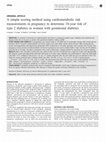
OBJECTIVE: To examine if clustering of cardiometabolic risk factors in pregnancy predicts type 2 ... more OBJECTIVE: To examine if clustering of cardiometabolic risk factors in pregnancy predicts type 2 diabetes and cardiovascular disease (CVD) risk at 10 years in women with gestational diabetes mellitus (GDM). STUDY DESIGN AND SUBJECTS: A prospective case–control study in 150 GDM and 72 overweight women with normal glucose tolerance (NGT) measured cardiometabolic risk factors (body mass index (BMI), systolic blood pressure (SBP), fasting glucose, insulin, and triglycerides and high-density lipoprotein (HDL) cholesterol) at 28 weeks gestation and 6 months and 10 years after pregnancy. Cluster analysis of cardiometabolic risk factors in pregnancy was used to stratify GDM as 'high' and 'low risk' for diabetes and CVD risk at 10 years. The data in pregnancy were used to determine a simple method for assessing risk of future diabetes. RESULTS: BMI in the 150 GDM at study entry was similar to NGT, but 35% of GDM fell into a 'high-risk cluster' with elevated BMI, SBP, glucose, insulin and triglycerides and lower HDL levels. At 10 years, type 2 diabetes was sixfold higher in 'high-risk' GDM (odds ratio (OR) ¼ 6.75, confidence interval (CI) ¼ 2.0, 22.7, P ¼ 0.002) compared with 'low-risk' GDM and was not reported in NGT. The 'high-risk' cluster predicted type 2 diabetes better than BMI430 (OR ¼ 2.13, CI ¼ 0.71, 6.4, P ¼ 0.179) or fasting glucose 45.5 mmol l –1 , (OR ¼ 4.56, CI ¼ 1.50, 13.85, P ¼ 0.007). We determined that GDM with any four of the cardiometabolic risk factors (BMI430 kg m –2 , fasting glucose45.0 mmol l –1 , insulin47.8 mU l –1 , triglycerides 42.4 mmol l –1 , HDLo1.6 mmol l –1 or SBP4105 mm Hg) in pregnancy would be in a 'high-risk' cluster. CONCLUSIONS: A metabolic syndrome-like cluster in pregnant GDM identifies risk for type 2 diabetes providing an opportunity to focus on rigorous lifestyle interventions after delivery to reduce the burden of disease attributed to this condition.










Uploads
Papers by Michael Phillips